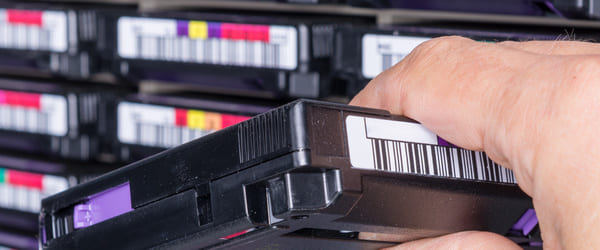databack success stories: Data migration from DDS tapes
In the dynamic world of enterprise data management, data migration is a recurring issue, especially when it comes to valuable data stored on older media: magnetic tape. At Databack, we were recently faced with an interesting challenge, one that may well change the minds of even the most skeptical tape users.
A customer approached us to take over an old stock of DDS tapes dating back to the 2000s. Lacking in-house technology and skills, the challenge was to secure, preserve and make this data accessible to the company.
Data migration : Why opt for tape storage?
Our data recovery services are complemented by comprehensive data migration solutions. At Databack, we are committed to tape storage. Far from being obsolete, they actually offer a reliable and proven solution for data storage and migration.
In this case, magnetic tapes provide infallible protection: once data is stored on the tapes, it is disconnected from the network and out of reach of cyberattacks. With ransomware attacks on the increase, this extra layer of security can significantly enhance your data protection.
The high capacity and robustness of tape storage are also two of its greatest assets. It can withstand environmental challenges far better than many modern digital solutions. If kept in the right conditions, magnetic tapes are capable of preserving data intact over an impressive period of time. This means that large quantities of data, stored on magnetic tape for decades, can be effectively restored.

Data migration from DDS tapes: A rigorous process
Let’s return to our customer’s case. Although DDS tapes may seem obsolete, they are in fact a mine of information that can still be useful to companies. The aim of data migration is not only to transfer data from one medium to another, but also to guarantee its security, accessibility and longevity. In the case of DDS tapes, data migration requires a methodical approach to guarantee their security and integrity. At Databack, our technical team follows a rigorous process to ensure success.
Verification of tape physical integrity
The first step in our approach is to assess the physical condition of the DDS tapes. We examine each tape to ensure that it has not suffered any physical damage that could compromise the integrity of the stored data. This may include signs of wear, such as tears or creases, which could make reading difficult or impossible.
File format study
At the same time, we’re looking at the file format used for data backup. Storage technologies have come a long way, and it’s possible that the format used then is no longer used today. Therefore, we need to identify the specific file format and ensure that we have the appropriate tools to read and convert this data into a modern, usable format.
Checking media history
When companies merge or are acquired, it is not uncommon for detailed information on the backup tools used in the past to be lost. Sometimes, the storage medium used at the time is no longer up to date, or documented. In such cases, we face the challenge of deciphering how the data was stored without having access to the original information or software.
Physical extraction of DDS tape content
Faced with the challenge of extracting data from DDS tapes, our technical team has created a reading tool specifically dedicated to this task. This software is designed to be versatile and capable of handling a variety of formats, and accurately extracting the content stored on each tape. Indeed, older DDS tapes may contain outdated or company-specific file formats. In such cases, standard playback tools may not be sufficiently equipped.
Creating a summary file
Once the data has been extracted from the tape, the next step is to convert it into a format that can be used by the customer. Whether the target format is an Excel file, a SQL database, or something else, our aim is to provide the data in a format that suits the customer and can be integrated into their existing systems with a minimum of fuss.
Migration of data to magnetic tape is therefore an effective solution to ensure the security and longevity of your data. For further information, contact our teams today.
5 September 2023








